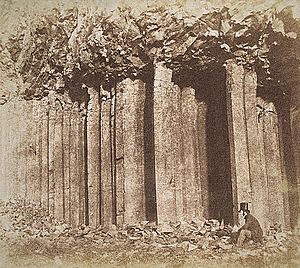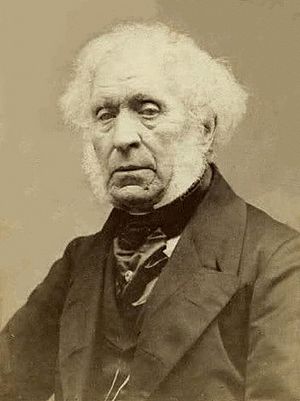Edinburgh Calotype Club facts for kids

The Edinburgh Calotype Club was a very important group in Scotland. It started in 1843 and lasted until the mid-1850s. This club was the first photography club ever created in the world! Its members were early photographers, mostly from Edinburgh and St Andrews. They worked together to create two of the world's first photo albums. These albums held more than 300 amazing pictures.
How the Club Started
The club began because of David Brewster. He was the head of St Andrews University. Brewster was also a close friend of Henry Fox Talbot. Talbot invented a photography method called calotype photography.
Talbot sent examples of his new photos to Brewster. Brewster then shared this new way of taking pictures with gentlemen in Edinburgh. He even suggested Talbot only patent his invention in England. This meant people in Scotland could use the calotype process freely. This freedom helped the club to form.
Brewster needed help to understand Talbot's process. So, he asked Dr. John Adamson, a chemistry professor at St Andrews. John Adamson was the first person in Scotland to use calotype photography. But his brother, Robert, became a passionate photographer. Robert later opened Scotland's first photo studio. He did this with a painter named David Octavius Hill. Their studio was called Hill & Adamson.
A student named James Montgomery visited Edinburgh. He and his friends were very interested in the calotype process. They learned about it from Brewster and John Adamson. This visit is thought to be how the Edinburgh Calotype Club officially began.
Who Were the Members?
The club's members were professional gentlemen. They came from different jobs and places. Many were priests, university teachers, or doctors. They lived in both Edinburgh and St Andrews.
The club meetings were usually relaxed. An old photography magazine from 1874 said the club had "neither laws, office-bearers, or formalities of any kind." This means they didn't have strict rules or leaders.
The magazine also described their meetings:
- "The meetings were held periodically at the houses of the members alternately."
- "Generally each took the form of a breakfast."
- "When some greater step than ordinary had been made... it was generally honoured by being introduced to the members at a formal dinner."
Even without many records, we know the names of eight members. The photo albums themselves list five members and some friends.
Important Members
Many famous people of that time were part of the club. They were mainly from Edinburgh and St Andrews. Some of them included:
- John Adamson (1810-1870), a doctor and chemist.
- David Brewster (1781-1868), a Scottish scientist and inventor.
- John Cay (1790-1865), a lawyer.
- Cosmo Innes (1798-1874), a Scottish historian.
- James Calder Macphail (1821-1908), a minister.
- James Montgomery (1818-1897), a lawyer and church leader.
- Mark Napier (1798-1879), a historian.
- Hugh Lyon Playfair (1786-1861), the leader of St Andrews.
- Henry Fox Talbot (1800-1877), the inventor of calotype photography.
- George Moir (1800-1870), a lawyer and writer.
- Robert Tennent (1813-1890) and his younger brother Hugh Lyon Tennent (1817-1874).
When the Club Ended
The Edinburgh Calotype Club met until sometime in the 1850s. We don't know the exact date it stopped. Experts at the National Library of Scotland think it was around the mid-1850s. This was when newer photo methods became popular. These new methods were called albumen and collodion processes.
The club had "outlived its usefulness" because of these changes. Photography became easier and more common. It "spread like wildfire over the country."
Some members of the club joined a new group later. This was the Photographic Society of Scotland, started in 1856. David Brewster became its President. George Moir was a vice president. Cosmo Innes became a council member.


